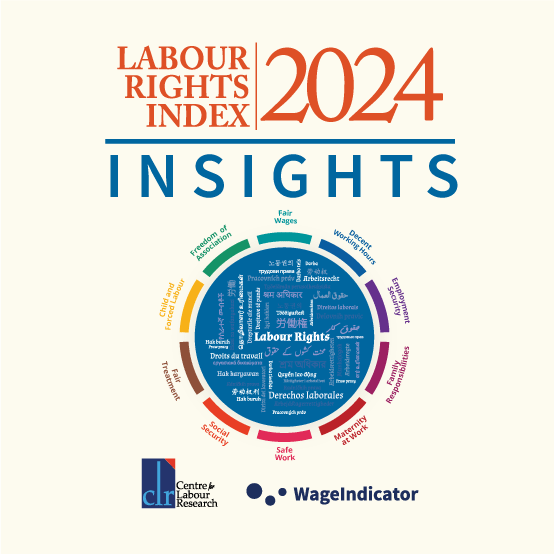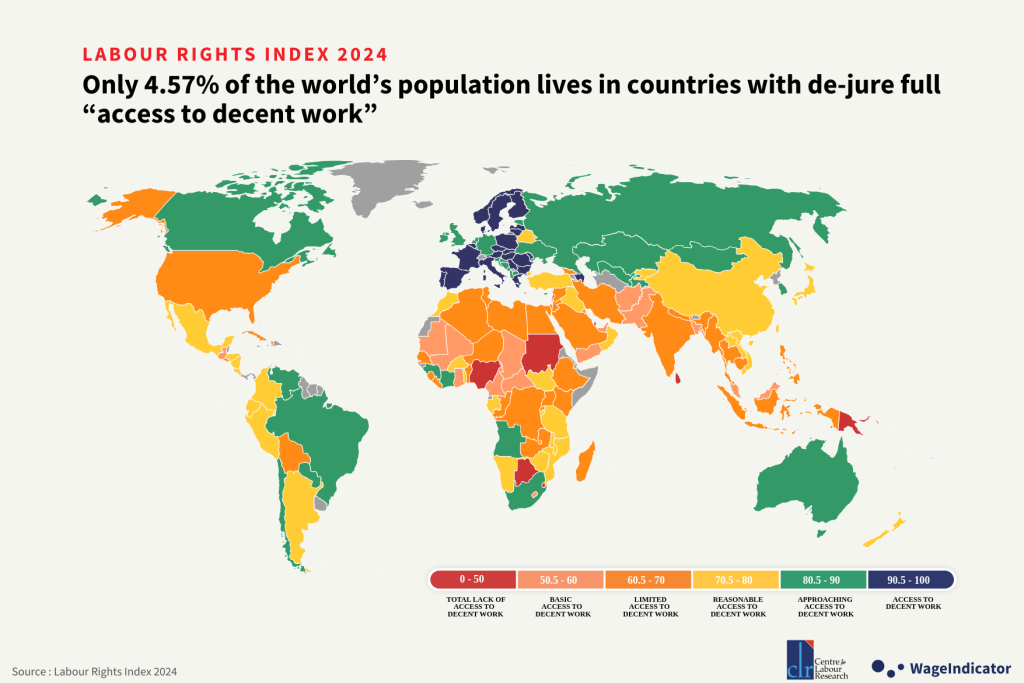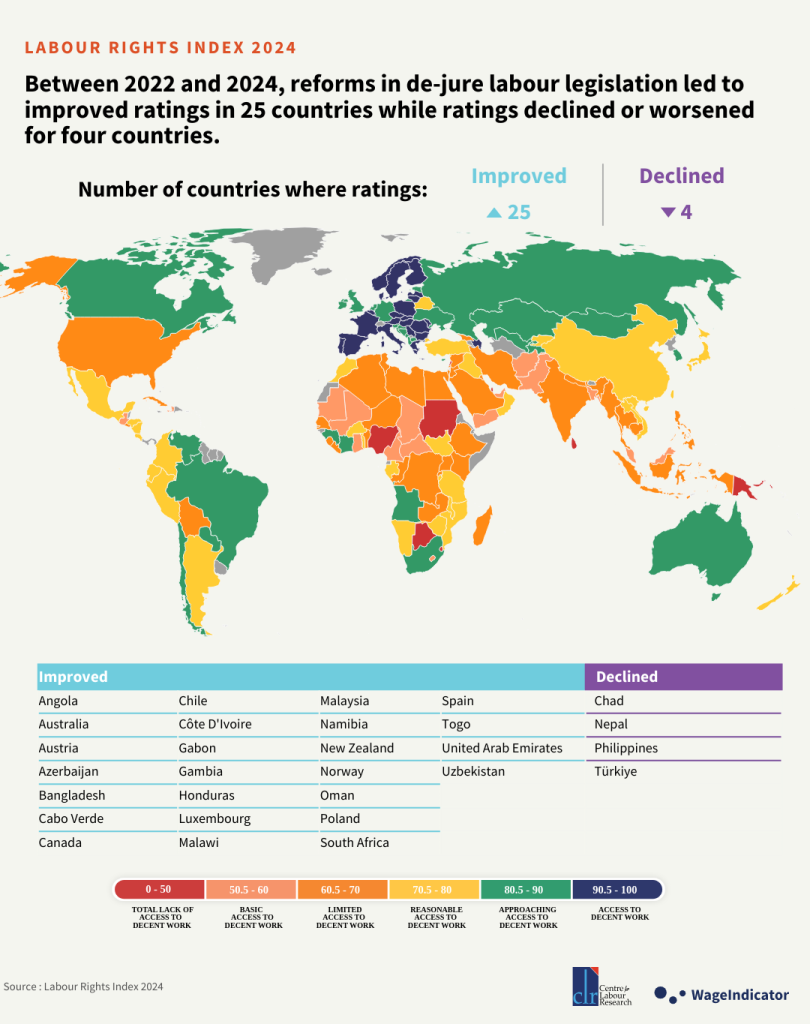Labour Rights Index 2024
- Score
- Ratings
Introduction
The 2024 Labour Rights Index, launched on the World Day for Decent Work (7 October), presents a promising outlook. It is a testament to the progress being made in labour legislation worldwide, with more and more countries aligning their laws with international standards, a clear march to the top instead of a widely claimed race to the bottom.
The Labour Rights Index, a collaboration between the WageIndicator Foundation (Netherlands) and the Centre for Labour Research (Pakistan), stands out as a comprehensive overview of workers’ rights in law. It rates 145 countries against ten indicators (46 subindicators), all derived from UN Conventions and ILO instruments and rooted in the ILO’s Decent Work Agenda.
Released biennially, the Index is a unique and comprehensive resource, considering its scale and scope. The third edition of the Labour Rights Index, building on the previous editions released in 2020 (115 countries) and 2022 (135 countries), provides objective legal data on labour laws in 145 countries. It is a valuable tool based on the principles set down in international labour standards.
Why analyse labour legislation?
The index measures countries against not some gold-plated or utopian standards; these represent the basic minimum conditions of work that every worker should get, and that the world has already agreed upon by adopting these ILO instruments and UN Conventions/Covenants. These are the basic labour protections or universal labour guarantees every worker should have access to, irrespective of contract or employment status.
Labour law comparisons are generally rare or restricted only to employment protection legislation, working conditions legislation, equality laws, or trade union rights legislation. In this background, the Labour Rights Index is the first comprehensive de-jure Index which follows an employment life cycle approach. It evaluates countries using ten indicators: fair wages, decent working hours, employment security, family responsibilities, maternity protection, safe work, social security, equal treatment, child and forced labour, and freedom of association. Based on their scores (ranging between 0 to 100), countries are graded on a six-point scale ranging from a “Total Lack of Access to Decent Work” to “Access to Decent Work”. The Index measures the presence or absence of relevant legislation and does not comment on the implementation of legislation or its compliance at workplaces.
Conceptual Framework labour rights index 2024
The conceptual framework of the Labour Rights Index is comprised of ten indicators further disaggregated into 46 sub-indicators. These are based on the Decent Work Agenda. These indicators and sub-indicators are presented as follows
Linkage with SDGs
The Labour Rights Index makes a significant contribution by focusing on SDG 8 (decent work and economic growth) and its Target 8.8 (protect labour rights and promote safe and secure working environments for all workers). It’s a crucial tool in achieving goal 8 under the Sustainable Development Goals, which refers to “full and productive employment and decent work for all”.
Although SDG 8 merges two separate areas of economic growth and employment into a single SDG, it is important to remember that issues related to the world of work are already part of the 20230 Agenda for Sustainable Development. Employment and employment-related issues are also referred to in other goals, including SDG 2 (Zero Hunger), SDG 3 (Good Health and Well-being), SDG 4 (Quality Education), SDG 5 (Gender Equality), SDG 9 (Industry, Innovation and Infrastructure), SDG 10 (Reduced Inequality), SDG 11 (Sustainable Cities and Communities), SDG 12 (Responsible Consumption and Production), SDG 13 (Climate Action) & SDG 16 (Peace, Justice and Strong Institutions). The achievement of some of these goals, especially reduction of poverty (SDG 1), eradication of hunger (SDG 2) and reduction of inequality (SDG 10) are all dependent on SDG 8 where people are engaged in full and productive employment and decent work for all is ensured.
The Sustainable Development Goals also recognise the importance of legislation in achievement of SDGs. For example, we can consider the following targets and indicators:
- 5.c Adopt and strengthen sound policies and enforceable legislation for the promotion of gender equality and the empowerment of all women and girls at all levels
- 10.3 Ensure equal opportunity and reduce inequalities of outcome, including by eliminating discriminatory laws, policies and practices and promoting appropriate legislation, policies and action in this regard
- 16.b Promote and enforce non-discriminatory laws and policies for sustainable development
Key Findings
The Labour Rights Index, launched on 7 October 2024, sheds light on de-jure labour rights in 145 countries. The biennial index, giving a snapshot of the de-jure labour rights for about 95% of the global population, registered a gradual march to the top instead of a widely claimed race to the bottom. However, only 4.57% of the world population is enjoying de jure “access to decent work”, though reforms are needed in the highest category as well.
According to the Labour Rights Index, more than 50% of the world’s population lives in countries where labour legislation provides only “limited access to decent work” or even worse situations. The percentage of the population living in the lowest (Total lack of access to decent work) and highest (access to decent work) categories is also similar (4% vs 4.57%, respectively). The two middle categories (Reasonable Access to Decent Work and Limited Access to Decent Work) cover 70% of the world’s population.

Labour Rights Index 2024 | Insights
The "Labour Rights Index 2024 - Insights" highlights global labor law reforms, focusing on equal job access, paternity leave, anti-discrimination measures, and improved working conditions for women.

Labour Rights Index 2024 | Methodology & FAQ
The Labour Rights Index 2024 Methodology and FAQs document details the labor rights assessment framework, covering ten key indicators, scoring criteria, assumptions, and limitations for global labor law comparison.

Labour Rights Index 2024 | Labour Law Maps
The Labour Rights Index 2024 presents global labor law maps for 46 components across 10 indicators, published biennially by the WageIndicator Foundation and Centre for Labour Research.








